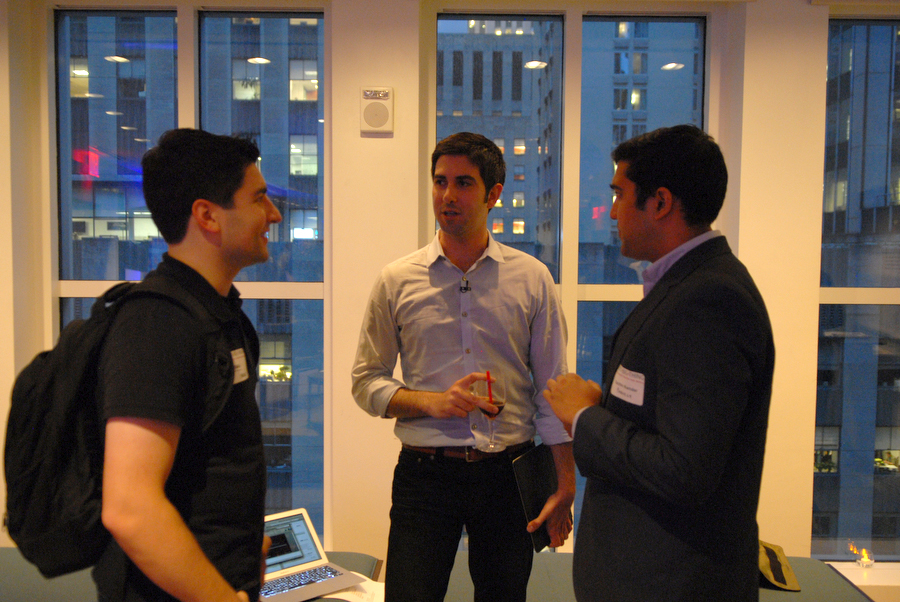The Startup Diet: How Our Founders Lost 10-15 lbs on $4 a Day

Editor’s Note: In 2009, when CEO Sachin Kamdar and CTO Andrew Montalenti founded Parse.ly and participated in the DreamIt incubator program, their goals included maximizing efficiency and productivity. Budgeting for food helped them cut costs and planning meals ahead carved out more time to focus on building their company.
Read Andrew’s original write-up about the experience from the early days of Parse.ly to learn how they built a meal plan based on beans and lost over 10 pounds on the Startup Diet.
Setting the Scene: Parse.ly, 2009

DreamIt Ventures had just cut us a check for $20K to get our startup off the ground. But my cofounder Sachin and I were worried. $20K seems like a lot of money, but it’s actually not that much. Not when you’re using it for both living expenses and to hire other people to get your company off the ground. So we started planning our spend and rationing the money immediately.
We knew we’d use some of the money for our living expenses. We had just arrived in Philadelphia, and we were living in a startup house with Matt and Burak, the founders of Tidal Labs, and Jack, one of the founders of SeatGeek. It turns out that rent wasn’t that expensive in Philly, especially in this arrangement. Instead, our number one cost, we determined, was going to be food.
The Next Meal
One of the founders of modern management, Peter F. Drucker, once wrote, “In all recorded history there has not been one economist who has had to worry about where the next meal would come from.” How true. But every startup entrepreneur I talked to obsessed with one thing and one thing only: “runway”. In other words, where the next meal would come from once the small amount of funding we got ran out.
With some good take-out and food truck options in University City (where DreamIt’s offices were), we were already spending as little as $10/person/day. But actually getting this food wasted valuable time, and it usually wasn’t very healthy. We heard reports of the “Startup 15″ — the 15 pounds many founders gain when beginning work on their companies. We also knew that when you eat like crap, it affects your productivity negatively. Finally, we knew healthier takeout options were prohibitively expensive. This presented a serious problem. Thinking like founders, we decided to hack this situation to our advantage.
Most companies at DreamIt figured it couldn’t get any better than the food trucks, and stuck to low-cost takeout most every day. We wondered — was there a way we could cut our food cost down, eat healthily, have positive productivity, save time, and hell, even lose weight in the process?
The Birth of a Good Idea
Thus was born The Startup Diet. What we needed was a diet with the following properties:
- Healthy, energy-filled food to enhance productivity
- Low daily calorie intake to prevent weight gain
- Idiot-proof and simple meal preparation
- Extremely cheap per-person cost
- Ability to purchase in bulk to reduce time wasted at supermarket
Sachin went online researching diet options and came across Tim Ferriss’s blog. Ferriss takes a scientific approach to living, and is best known for his popular book, The 4-Hour Work Week. The relevant article Sachin found was called How to Lose 20 lbs. of Fat in 30 Days… Without Doing Any Exercise. This provided an excellent starting point.
The Four Rules
I encourage you to read his post, but for the impatient, here are his rules:
- Rule #1: Avoid “white” carbohydrates
- Rule #2: Eat the same few meals over and over again
- Rule #3: Don’t drink calories
- Rule #4: Take one day off per week
The diet we came up with was basically a fork of Ferriss’s. We followed his four rules. The most important of these ended up being rules #2 and #4. By turning our meals into a routine, it became much easier to make them efficient and reduce the time spent buying, prepping, and cooking food. By taking one day off per week, we didn’t feel that we were “missing out” on important business opportunities as a result of our diet — e.g., lunch appointments with mentors or a night out at the bar to blow off steam with the team and other founders. Our “cheat day” also had an interesting other efficiency effect: we were just forced to schedule all of our breakfast/lunch/dinner meetings for a single day, and thus didn’t interrupt our work week with distractions.
The Core Insight: Beans as a Base
The goals of our diet were different than Ferriss’s. But like him, we used beans/legumes as a base. Beans are an excellent base food for a startup diet because they meet all of our core requirements above. But the best thing about beans is their startup economics. If you consider that our goal is to ingest the cheapest/healthiest possible calories, you can’t find a more flexible foodstuff than canned black beans. You can buy organic canned black beans for as little as $1.50/can. One can of beans is around 600 calories.

If you look at black beans from an efficiency standpoint, you get 4 calories per $0.01. Compare a slice of pizza which is 200 calories and will usually run you $2.50; that’s only about 0.8 calories per $0.01, making beans about 5X more efficient. But beans aren’t just more energy-efficient, they’re also loaded with protein and fiber (about 7g of each per serving). Most of the cost in a diet comes from eating expensive proteins like chicken and beef, and beans have the ability to provide both efficient calories and efficient proteins at the same time. Finally, you can buy canned beans in bulk and store them.
For other nutrition, we would lean on four more sources: eggs; salad (mixed greens, romaine lettuce, tomatoes, and peppers); prepackaged vegetarian protein sources like tofu, seitan, and wheat gluten which we would use sparingly; and canned soups.
The Trial Run
We went to the supermarket to run our first trial. We knew this would need some coordination. Our first trick was to make an up-front investment in lots of differently-sized Ziploc containers and canvas carrying bags, so that we could flexibly relocate food where we needed it (home, office).
We wanted to prep food for the week ahead of time and bring it into the office to ensure we didn’t cheat on the diet. The next trick was to come up with a meal plan using the four rules and our beans-as-a-base theory. Here is the meal plan we came up with:
- Breakfast: alternate between 2 eggs per person or vegetarian saussage links; add hot sauce and side of mixed greens.
- Lunch: alternate between mixed salad with one can of soup (we liked Split Pea and Lentil) or salad with black beans on top. We would prep the salad for the week in zip lock containers, and leave the rest of the things we needed (e.g. salad dressing or the canned beans) at the office.
- Dinner: a combination of black beans, vegetarian protein (usually “chicken” strips or “beef” rips), hot sauce, onions, and jalapeño peppers. We would eat this “core” food like a burrito stuffing, but instead of putting it in a tortilla, we would eat it with romaine lettuce wrappings. (Think “Lettuce Wraps” that you can get at fancy New American / Asian restaurants.) The great thing about this as our dinner food is that we could make the filling ahead of time for 2-3 days and then just reheat it. Fresh Romaine Lettuce has a great crunch and lets you eat the food with your bare hands, even minimizing dish cleanup time. We just had to keep a regular supply of Romaine Lettuce on-hand.

An Agile-Friendly Startup Diet
I mentioned Matt from Tidal Labs. He was also our landlord. His Spruce Hill House was the perfect atmosphere for getting some serious summer hacking done. But one of the nicest — and eventually, most useful — things about the house was the huge kitchen and huge Sub Zero refrigerator. Matt later told me bought the refrigerator off eBay for a $1 (it wasn’t functional and the owner just wanted to get rid of it), and then Matt fixed it himself. He is scrappy and awesome that way.
Sachin and I treated this Sub Zero fridge as our diet command center. We would prep our meals before and after our long days at the office. One of us would prep breakfast for the day while the other prepped lunch/dinner materials for the next 2 days. We’d collaborate on prepping dinner. Every couple days, we’d swap.
We cherished this time for its management value to the company. In the morning, we’d have a founder standup: we’d figure out the things we wanted to accomplish for the day while prepping and eating breakfast. We’d evaluate the day over dinner, a kind of mini retrospective. The Startup Diet became a kind of management technique.

Making It Work
Perhaps by now you’re convinced that this diet has a lot of cost and efficiency benefits. You can’t beat living on $4/person/day for food. You can’t beat saving (by our estimate) 1-2 hours a day on prep and meal time.
But, the main question we get about this was, didn’t that taste horrible? Surprisingly, no. We used a lot of obvious flavor enhancers to keep things tasting pretty good. We invested in good olive oil, sea salt (in a grinder), black peppercorns (in a grinder), and threw in a liberal helping of spices, hot sauce, and herbs.
The second common question we get was, wasn’t it mind-numbingly boring to keep eating the same thing over and over again? Again, surprisingly, no. The first week you wonder how you’ll go a whole summer like this. The second week, it just becomes the routine.
Remember, startups are hard in the early stages. Every day requires your fullest attention. Therefore, turning meals into a routine actually made a lot of sense — it reduced the degree to which we were interrupted in getting the company off the ground. Our body got used to it, and we hardly even noticed that we were eating the same meals week by week. Rule #4, the cheat day, was the real savior in this aspect. We used to look forward to our cheat days, and we made them count. Cheat days also acted as a kind of reward for a week of focused work.
Making It Your Own
I am not a doctor or a nutrition expert, and so all the regular caveats apply. But this was how we were able to keep our costs down while Parse.ly was being incubated at DreamIt Ventures.
Learn to love black beans and other legumes — they are a healthy, flexible and efficient food. Plan your approach. Turn eating into a routine, and prepare most of your meals ahead of time. Cut out the carbs, beer and soda — drink lots of water instead. Use meal prep time to manage your company. Use your cheat day to manage external relationships and reward yourself.
Stay focused on your startup. Lose weight. Gain productivity. Extend your runway.
The rest is up to you.
This article was originally posted in 2010 and has been updated.
Sachin and Andrew’s hard work to save time and money paid off. Today, Parse.ly works with over 700 media websites, including Ars Technica, The Telegraph, and Mashable. Parse.ly was recently ranked #279 on the 2016 Inc. 5000 list of fastest-growing companies and named one of Crain’s 100 Best Places to Work in New York City in 2016.